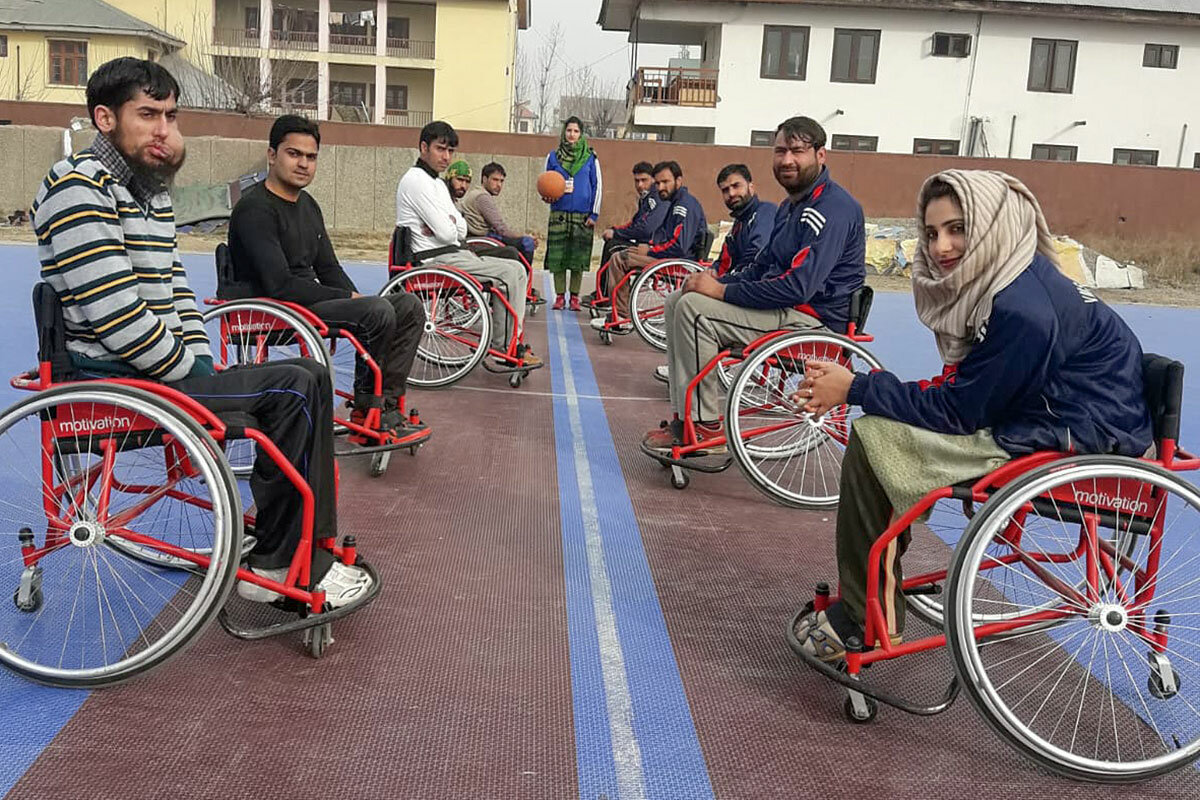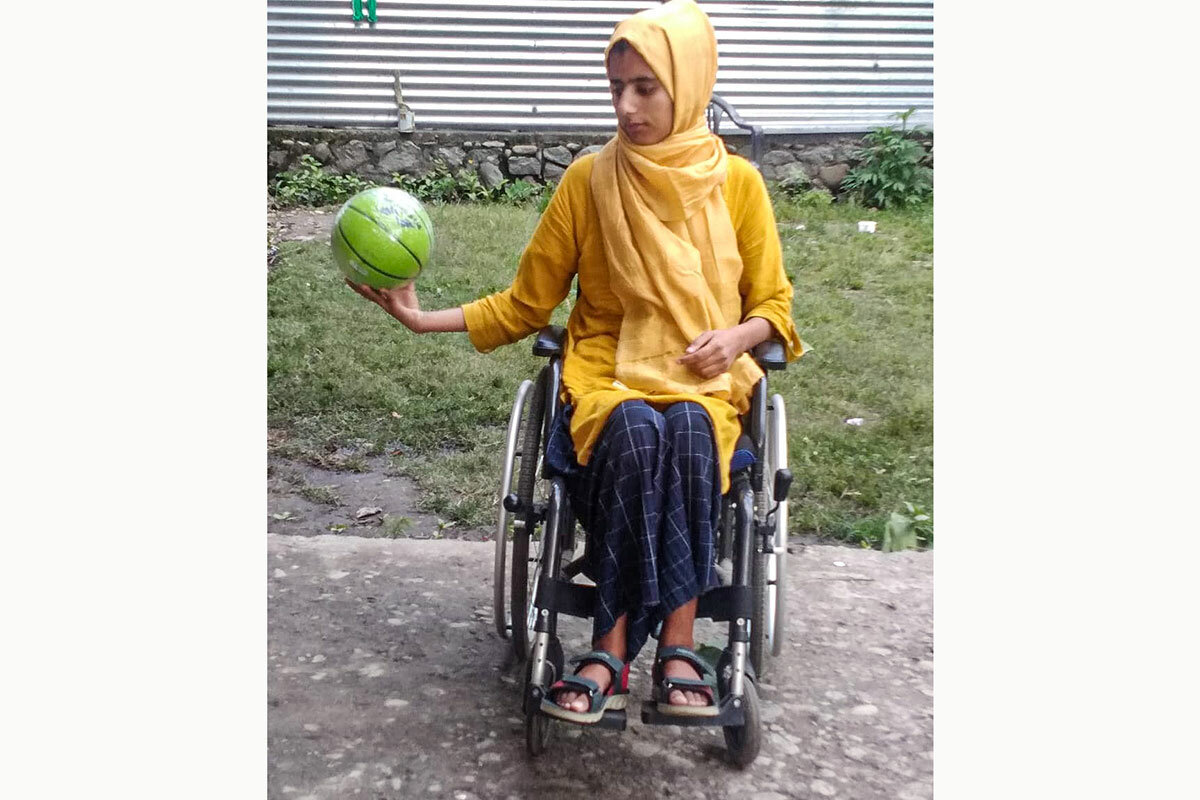‘I gained a new purpose’: Kashmiri women embrace wheelchair basketball
Loading...
| Srinagar, India
Inshah Bashir was just 15 when she fell from the third floor of her under-construction house in Kashmir’s Budgam district and lost mobility in her legs. Although 14 years have passed, Ms. Bashir still vividly remembers that period in her life after the accident.
“In a region like Kashmir, where even able-bodied people struggle to live their daily lives, there was little hope for a disabled woman,” says Ms. Bashir, who uses a wheelchair. “My disability threatened to put an end to my dreams of independent life.”
But that isn’t where Ms. Bashir’s story ends. Eventually, she convinced her parents to let her enroll at Shafaqat Rehabilitation Center in Srinagar – on the condition that a family member accompanies her – and found new hope on the center’s basketball court. She trained with the men’s wheelchair basketball team, and has since traveled around India and the world to compete in tournaments, even representing India at a sports leadership program in the United States in 2019. Ms. Bashir now serves as the captain of Kashmir’s first wheelchair basketball team for women.
Why We Wrote This
A story focused onIn Kashmir, where traditional culture and lack of resources make it difficult for disabled women to live independent lives, a wheelchair basketball team is offering hope.
In Kashmir, where disability representation and resources are in short supply, Ms. Bashir and her teammates have helped draw attention to disability rights, while offering young women hope for a brighter future. Their stories show how adaptive sports can be an on-ramp to greater independence and help disabled people become more confident.
“Players move past their disabilities and focus on the game. This helps them come out of depression and become more independent, along with becoming socially active and good communicators,” says Louis George, a coach with Wheelchair Basketball Federation of India, which organizes basketball camps and selects players for the national teams.
Ms. Bashir, who delivered a TEDx talk about her athletic journey in 2020, says basketball helped her overcome feelings of hopelessness.
“The first time I put the basketball in the net, all my negative thoughts vanished. I had gained a new purpose,” she says.
State of disability rights
In December 2016, the Indian Parliament passed the Rights of Persons With Disabilities Bill, which added 14 recognized disabilities, suggested penalties for discrimination, and increased the education and government job quotas for disabled people from 3% to 4%. However, this is yet to be implemented in Jammu and Kashmir, the territory that encompasses Kashmir valley and has one of the highest disability rates in India, according to latest census reports.
“Infrastructure in the Union Territory is not disabled-friendly, especially in public offices and educational institutions,” says disability rights activist Javid Ahmad Tak, who uses a wheelchair and founded the Humanity Welfare Organization Helpline, a nonprofit organization to help the disabled community in the territory.
There are only 15 disability centers in Jammu and Kashmir, according to Annamalai University in Chidambaram, India, each with a capacity of about 40 people. The territory has hundreds of thousands of people with disabilities living across many districts.
Mr. Tak says new sports initiatives can be a source of financial income for women, as well as a way to help build support systems, but that more work needs to be done on the state level.
“At least one center should be in each district to facilitate disabled people, especially women, to get involved in different activities,” Mr. Tak says, adding that basketball and other forms of engagement such as computer skills training can “help to bridge the gap of segregation and loneliness the disabled go through.”
This rings true for Ishrat Akhtar. She was 16 when a spinal cord injury changed her life forever, and like Ms. Bashir, the young woman took years to come to terms with her new body. Then, one day, she was passing through Shafaqat Rehabilitation Center and spotted a group of men playing basketball in wheelchairs.
“When I asked them if I could join, they happily welcomed me and trained me for the next few months. There has been no looking back since then,” says Ms. Akhtar, who was one of the first to join the new women’s team along with Ms. Bashir in 2018.
Breaking perceptions, finding hope
Still, playing sports as a disabled woman in the traditional society “has not been only accolades and appreciation,” says Ms. Akhtar. As in many parts of the world, disabled people in Kashmir are often treated like burdens, and in a region where many lower- and middle-class families still view marriage as women’s primary obligation, these attitudes are amplified toward disabled girls.
“I faced a lot of criticism” for playing basketball, she says. “But I had to train myself to only focus on my own growth.”
Voluntary Medicare Society, which runs Srinagar’s Shafaqat Rehabilitation Center and coordinates both the men’s and women’s wheelchair basketball teams, had tried to start a women’s team prior to 2018, but was unable to find enough players.
“Initially, it had been very challenging to put the team together,” says Mohammad Rafee, member and coordinator of the men’s wheelchair basketball team in Kashmir. “Traditional families were too reluctant to allow the young women to pursue sports along with their disability.”
But the women’s team “has helped in breaking that perception,” he adds. “It has been great to see these women grow and participate in different competitions at the national and international level.”
Having a local team makes basketball more accessible for Kashmiri women, who would otherwise need to travel to Delhi or other parts of India to pursue an athletic career – an especially difficult task for those who use wheelchairs. And for young women navigating a new disability, simply seeing yourself reflected on the basketball court can have a huge impact.
When Humera Ashraf damaged her spinal cord in 2020, the injury pushed the teenage medical student into isolation. “I thought I would not be able to walk or move, and this thought made me crazy,” she says. “I felt everything came to a halt.”
But during a stint at Shafaqat Rehabilitation Center, she felt hopeful seeing the women’s wheelchair basketball team use the premises to train.
“It was here that I met other women who helped me understand that my life was far from over,” says Ms. Ashraf, who has since joined the team and resumed her medical studies.









